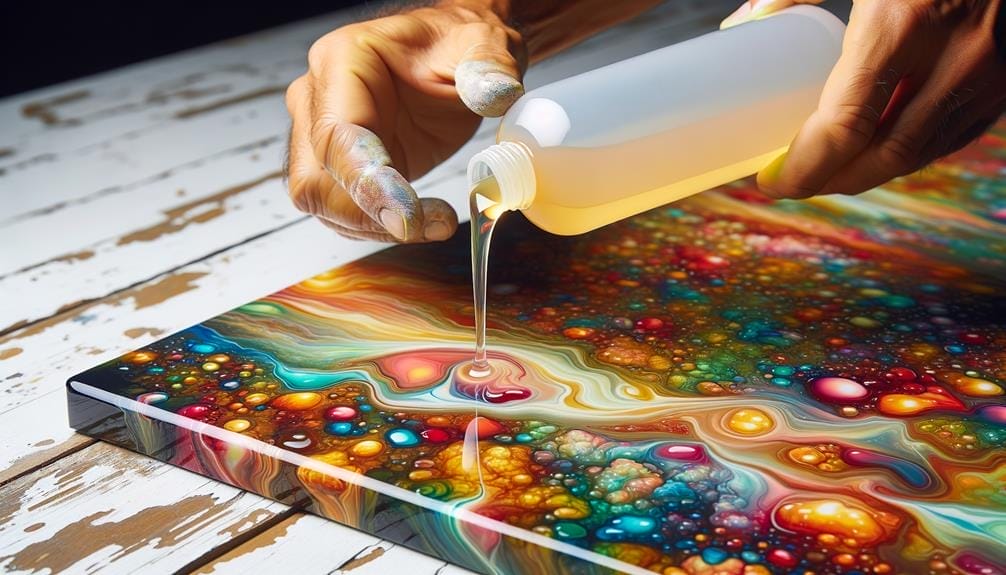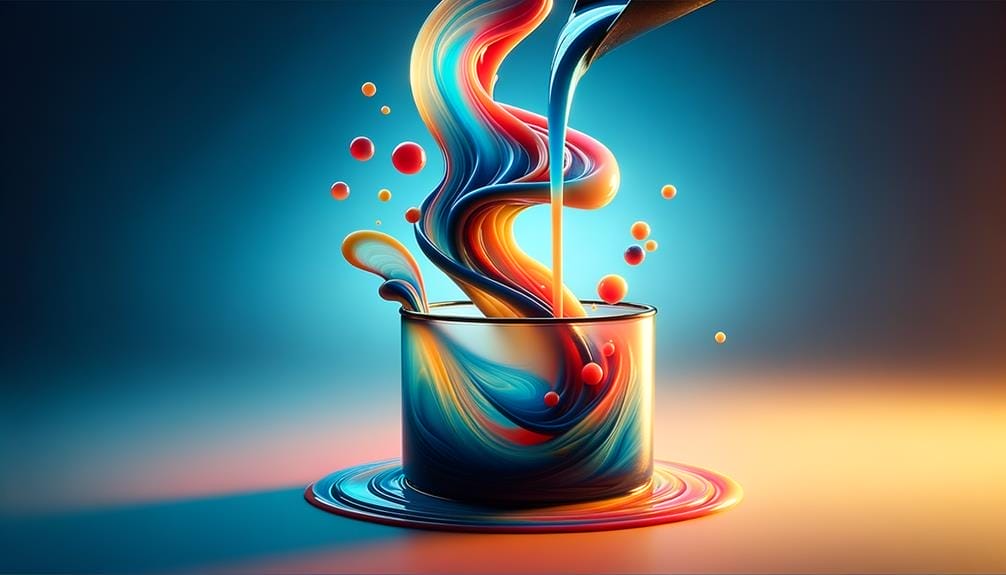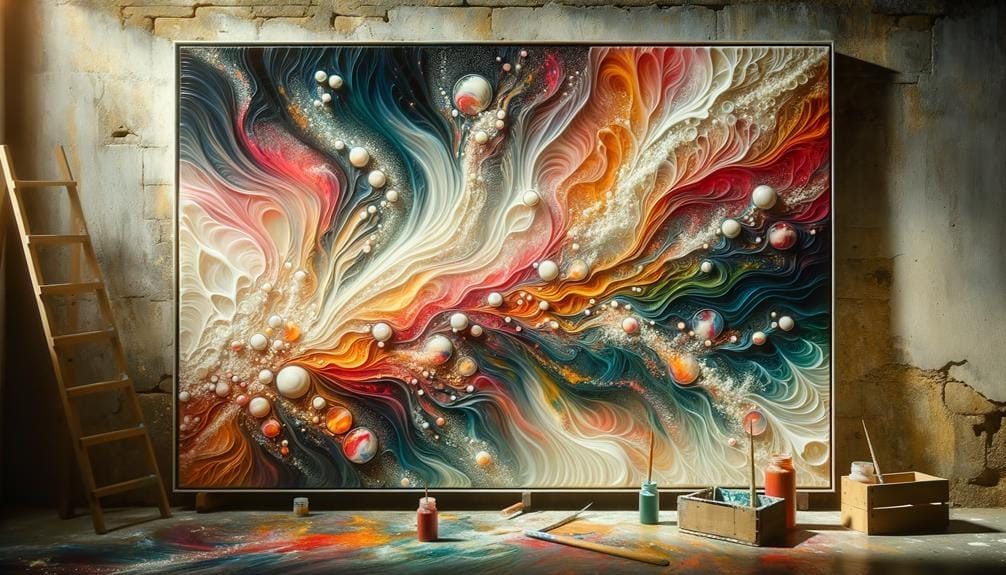Abstract resin art is a captivating creative endeavor with its mesmerizing mix of materials and magnificent manipulation. Artists bring life and vibrancy to a seemingly ordinary liquid polymer through the artistry of pouring, layering, and manipulating resin. But that’s just the beginning. Delving into the world of abstract resin art reveals a multitude of techniques, colors, and mixed media possibilities. This exploration will leave you yearning for more. Embark on this artistic journey together and uncover the endless possibilities that abstract resin art has to offer.
Key Takeaways
- Abstract resin art allows for versatility and freedom of interpretation, making it a popular choice for unique and artistic decor.
- Different types of resin, such as epoxy, polyester, polyurethane, and casting resin, offer various effects and properties for achieving desired outcomes in resin art.
- Techniques in abstract resin art involve the use of pigments, dyes, and powders, as well as tools like heat guns and blow torches, to create unique patterns and textures.
- Choosing colors and color harmonies is crucial in resin art, with options like contrasting colors, analogous colors, and monochromatic palettes offering different effects and visual appeals.
What Is Abstract Resin Art?
Abstract resin art is a captivating and visually striking form of artistic expression that utilizes resin as a medium to create non-representational and unique artwork. It’s a versatile art form that allows artists to explore their creativity by incorporating a variety of colors, textures, and techniques. Resin abstract art pieces aren’t bound by the constraints of representation, allowing for complete freedom of interpretation. Artists use resin pour techniques, pigments, and mica powders to craft these visually appealing and sophisticated creations.
The use of resin as a medium in abstract art adds a unique dimension to the artwork. Resin is a liquid material that hardens into a glossy and transparent finish, creating a sense of depth and complexity in the artwork. The colors and textures created with resin can be vibrant and dynamic, resulting in visually stunning pieces.
Abstract resin art is well-suited for modern and timeless interior settings. Its individuality and visual appeal make it a popular choice for those seeking unique and artistic decor. The non-representational nature of resin abstract art allows it to seamlessly blend into different design styles, adding a touch of sophistication and artistic flair to any space.
Materials Used in Abstract Resin Art
When it comes to abstract resin art, the materials used play a crucial role in achieving the desired effects. Different types of resin, such as epoxy resin, offer unique characteristics and properties that can enhance the final artwork.
Mixing techniques also come into play, allowing artists to create various textures, patterns, and color gradients within their resin pieces.
Resin Types
One of the key elements in creating captivating abstract resin art is the careful selection of resin types, as they play a crucial role in determining the final result of your artwork.
Epoxy resin is a popular choice due to its strong adhesive properties and high-gloss finish. It’s often used to create stunning ocean-themed pieces, as it can mimic the look of water perfectly.
Polyester resin, on the other hand, is known for its affordability and fast curing time, making it suitable for larger projects.
If you plan on displaying your resin art outdoors, polyurethane resin is the way to go, as it offers excellent UV resistance.
For those interested in embedding objects in their artwork, casting resin is specifically formulated to create clear, bubble-free castings.
If you’re an environmentally conscious artist, consider using bio-based resin, which is made from renewable resources.
Mixing Techniques
To further explore the world of abstract resin art, let’s now delve into the mixing techniques and materials used to create captivating and vibrant resin artworks.
Resin art involves the use of various materials such as resin, epoxy, and color pigments. These materials are essential for achieving stunning color effects and depth within the resin. Artists often incorporate pigments, dyes, inks, and powders to create unique patterns and textures.
Tools like heat guns, blow torches, and mixing sticks are used to blend the resin and pigments seamlessly. Additionally, incorporating natural elements like wood, metal, or glass within the resin art piece enhances the visual appeal and adds an extra dimension to the artwork.
Understanding the proper ratio of resin to hardener is crucial for achieving the desired consistency and curing process for the resin art.
Techniques for Creating Abstract Resin Art
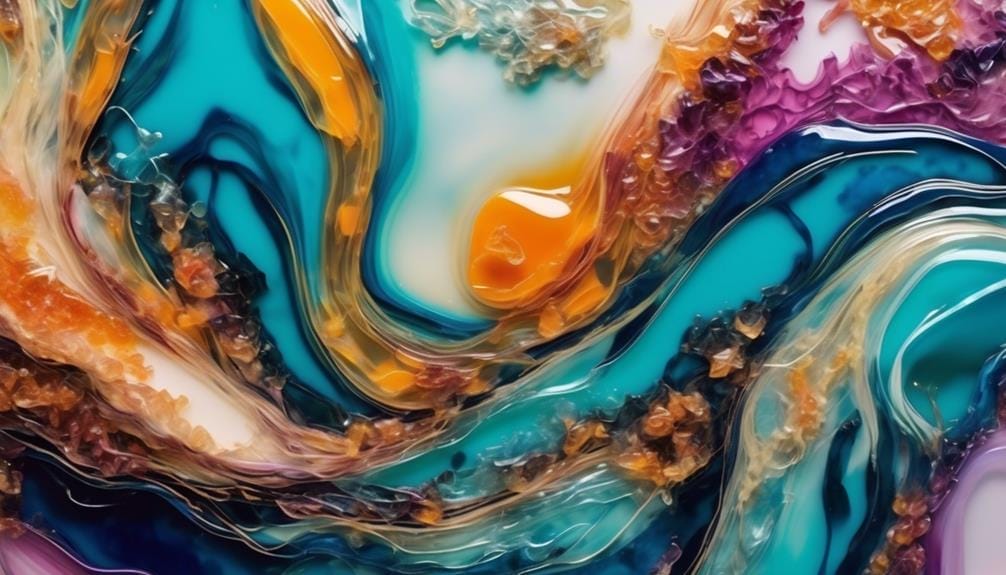
Creating captivating abstract resin art involves utilizing a myriad of techniques, including resin pouring, layering, and swirling, to achieve visually stunning and dynamic compositions.
Resin pouring is a technique where the resin is mixed with pigments, dyes, or metallic powders and then poured onto a canvas or other surface. This allows for the creation of vibrant and fluid abstract designs.
Layering is another technique that involves building up multiple layers of resin and other materials to create depth and dimension in the artwork. By adding various materials such as crushed glass, glitter, or natural elements like wood or stones, artists can enhance the texture and interest of their resin art pieces.
Swirling is a technique where the resin is manipulated using tools such as heat guns, blow torches, or alcohol ink to create intriguing patterns and effects within the resin. This technique allows for the exploration of the fluid and unpredictable nature of resin, resulting in one-of-a-kind abstract designs.
Choosing Colors for Abstract Resin Art
When it comes to choosing colors for your abstract resin art, understanding color harmonies can greatly enhance the overall visual impact of your piece.
By utilizing complementary colors, you can create a vibrant and dynamic contrast, while analogous colors can bring a sense of harmony and unity.
Experimenting with different color combinations will allow you to discover unique and captivating effects, adding depth and interest to your resin art.
Color Harmonies for Resin Art
Choosing the perfect color harmonies is crucial when creating captivating and visually striking abstract resin art. The combination of colors can evoke different emotions and set the overall mood of the artwork.
Consider these key factors to achieve harmonious color schemes in your Abstract Resin Art:
- Contrast: Experiment with contrasting colors to create a dynamic and eye-catching composition. Pairing complementary colors, such as blue and orange or red and green, can create a visually striking effect.
- Analogous Colors: Selecting colors that are adjacent to each other on the color wheel will result in a harmonious and cohesive look. For example, blending shades of blue, green, and purple can create a serene and calming atmosphere.
- Monochromatic Palette: Working with a single color and its different shades and tints can create a sense of unity and simplicity in your Abstract Resin Art. Exploring various intensities of a single hue can produce a visually stunning and cohesive piece.
Experimenting With Color Combinations
To explore a diverse range of captivating color combinations for your abstract resin art, it’s essential to experiment with various hues, tones, and shades.
Abstract resin art allows for endless possibilities when it comes to color choices. The colors you choose can evoke different emotions and create a unique visual experience for the viewer.
When selecting colors, consider the mood or atmosphere you want to convey. Bold and vibrant colors can create a sense of energy and excitement, while softer pastel tones can elicit a feeling of calmness and tranquility.
Experiment with contrasting colors to create visual interest and depth in your resin art. Complementary colors can create a harmonious balance, while analogous colors can offer a more subtle and cohesive look.
Don’t be afraid to mix and match different colors to discover unexpected and stunning combinations for your abstract resin art.
Tools and Supplies for Abstract Resin Art
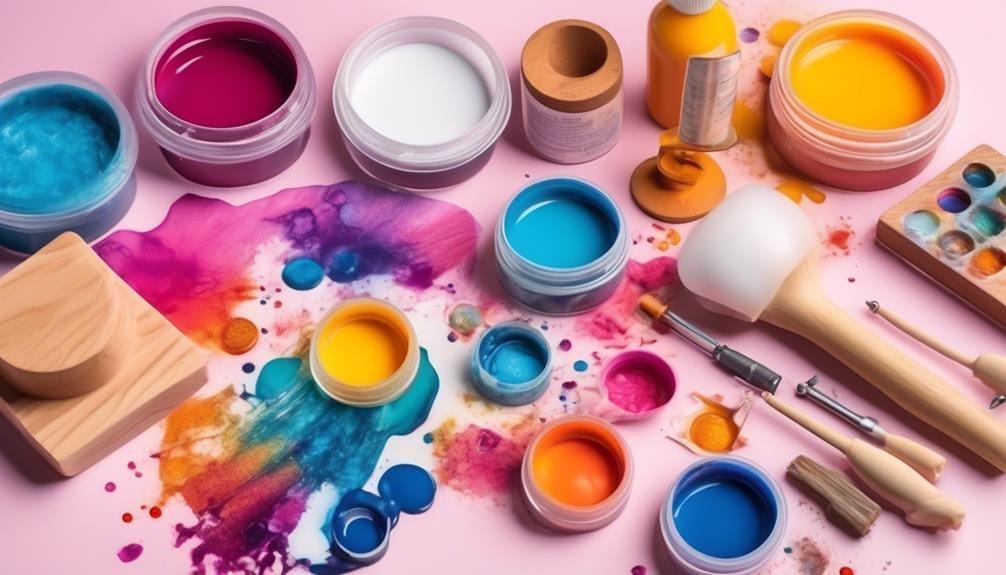
Abstract resin art requires specific tools and supplies to bring your creative vision to life. Here are three essential items you’ll need:
- Epoxy Resin: The backbone of abstract resin art, epoxy resin serves as the primary material for creating stunning and vibrant artworks. Its self-leveling properties and glass-like finish make it perfect for achieving a smooth and professional look.
- Pigments and Mica Powders: Pigments and mica powders are indispensable to add depth and color to your resin art. These additives offer a vast range of color options, allowing you to create unique and visually appealing designs that capture the essence of your artistic expression.
- Heat Gun or Torch: Air bubbles can be a common issue when working with resin. To ensure a flawless finish, a heat gun or torch is necessary. By gently passing the heat source over the surface of your artwork, you can eliminate any trapped air bubbles, resulting in a smooth and polished final piece.
Tips for Beginners in Abstract Resin Art
When starting with abstract resin art, there are three key points to keep in mind.
First, gather the necessary materials and tools, such as resin, pigments, and molds, to create your artwork.
Second, learn how to properly mix the resin to achieve the desired consistency and avoid any unwanted bubbles.
Lastly, embrace your creativity and experiment with different techniques and designs to create unique and captivating resin art pieces.
Materials Needed
For optimal results in abstract resin art, it’s essential to use a high-quality, crystal-clear epoxy resin. This type of resin ensures that your artwork will have a glossy, glass-like finish, allowing the colors and effects to shine through.
When creating resin geode art, it’s important to have the right materials on hand. Here are three items you’ll need:
- Pigments and colorants: Resin pigments and mica powders are perfect for adding vibrant colors and unique effects to your resin geode art. Experiment with different shades and combinations to create stunning visual effects.
- Mixing tools: Invest in silicone measuring cups, stirring sticks, and a heat gun. These tools will help you achieve thorough mixing of the resin and pigments, as well as remove any unwanted air bubbles.
- Protective gear: Always prioritize safety when working with resin. Use gloves and a respirator, and work in a well-ventilated area to protect yourself from the fumes and ensure a safe environment for resin handling and curing.
Mixing Resin Properly
To achieve optimal results in abstract resin art, it’s crucial to master the art of properly mixing resin. This step is essential as it ensures the resin and hardener are combined in the correct ratio, preventing any curing issues. Follow the manufacturer’s instructions and measure the components accurately.
Thoroughly mix the resin and hardener for at least 3-5 minutes, scraping the sides and bottom of the mixing container to ensure a complete blend. Take care not to mix too quickly, as this can introduce air bubbles. If bubbles form, you can use a heat gun or torch to remove them.
Remember to use separate, clean mixing cups and stirring sticks for each batch of resin to avoid contamination. Additionally, protect your work surface with a silicone mat or parchment paper, as cured resin can be challenging to remove.
Creating Unique Designs
Mastering the proper mixing technique sets the foundation for successful creations in abstract resin art; now, let’s explore how to create unique designs, especially for beginners in this art form.
When it comes to abstract resin art, the possibilities are endless. Here are three tips to help you create one-of-a-kind designs:
- Experiment with different color combinations: Abstract resin art allows you to play with an array of vibrant colors. Mix and match different hues to create visually striking compositions.
- Use various pouring techniques: Try pouring the resin in different ways, such as layering, flipping, or tilting the canvas. Each technique will produce a distinct pattern and texture, adding depth and interest to your artwork.
- Incorporate different materials: Abstract resin art can be enhanced by adding various materials like glitter, metallic pigments, or dried flowers. These elements can create captivating effects and add a touch of uniqueness to your designs.
Creating Texture in Abstract Resin Art
Creating texture in abstract resin art can elevate the visual impact of your artwork and add depth and dimension to your final piece. Texture is a crucial element that engages the viewer’s senses and creates a tactile experience. It allows the artwork to come alive, capturing attention and creating a dynamic visual experience.
There are various techniques you can use to create texture in abstract resin art. One method involves adding different materials to the resin mixture before pouring it onto the canvas. You can experiment with adding sand, glass beads, or even dried flowers to create interesting textures and patterns.
Another technique is to use a palette knife or a brush to create texture directly on the resin surface. You can create bold strokes, swirls, or even intricate patterns by manipulating the resin with these tools.
Additionally, you can experiment with different layering techniques to create texture. By pouring multiple layers of resin and allowing each layer to partially cure before adding the next one, you can create a sense of depth and dimension. This layering technique can result in a visually captivating artwork with an intriguing texture.
Creating texture in abstract resin art allows you to push the boundaries of your creativity and enhance the overall aesthetic appeal of your artwork. By incorporating different materials, experimenting with tools, and layering techniques, you can create unique and visually stunning textures that make your abstract resin art truly stand out.
Adding Metallic Effects in Abstract Resin Art
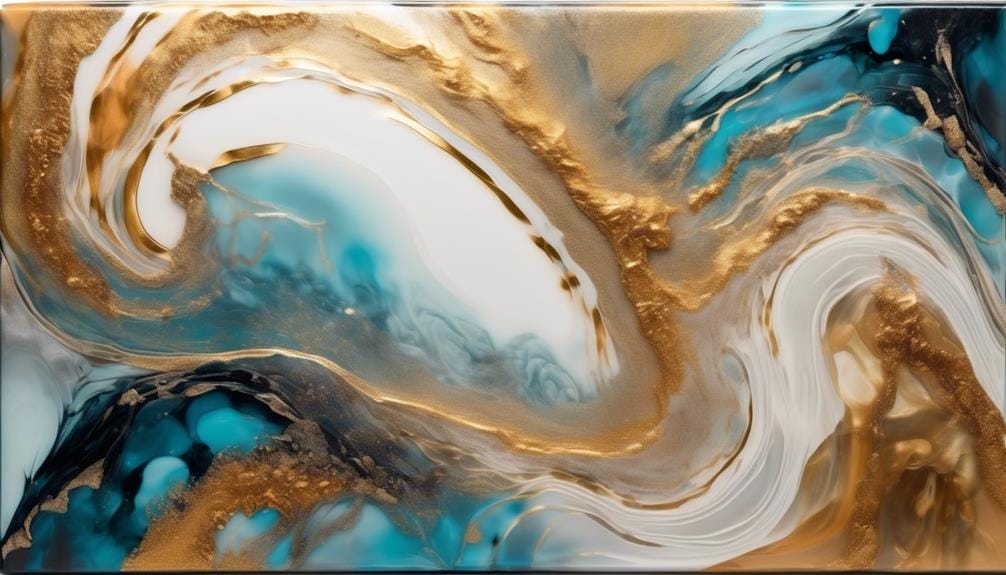
Continuing the exploration of enhancing the visual impact of abstract resin art, the addition of metallic effects introduces a captivating element that elevates the overall aesthetic appeal of the artwork. By incorporating metallic effects into your abstract resin art, you can create a sense of depth and dimension that adds a touch of brilliance to your masterpiece. The interplay between light and the reflective properties of metallic pigments creates a dynamic visual experience that engages the viewer’s senses.
Here are three ways to incorporate metallic effects in your abstract resin art:
- Mixing metallic pigments with resin: By blending metallic pigments with resin, you can create a base layer that shimmers and shines. This technique allows you to achieve a seamless integration of metallic effects throughout your artwork.
- Using metallic leaf or foil: Applying metallic leaf or foil onto the resin surface can add an intricate and delicate touch to your abstract resin art. The metallic leaf or foil can be torn, crumpled, or arranged in various patterns to create unique textures and visual interest.
- Incorporating metallic powders: Metallic powders, such as mica or pearl powders, can be sprinkled onto the resin surface to create a sparkling effect. By using a brush or your fingers, you can distribute the metallic powders in a controlled manner, allowing you to achieve the desired level of intensity and shine.
Incorporating metallic effects in your abstract resin art opens up a world of possibilities for experimentation and creativity. Whether you choose to mix metallic pigments, use metallic leaf or foil, or incorporate metallic powders, these techniques offer a level of sophistication that enhances the overall visual impact of your artwork.
Incorporating Mixed Media in Abstract Resin Art
Incorporating mixed media in abstract resin, art adds a captivating dimension of texture and visual interest to the artwork. By introducing elements such as glass, sand, paper, or fabric, artists can create a tactile experience that enhances the overall aesthetic appeal. The use of mixed media techniques in resin art allows for endless creative possibilities, enabling artists to combine various materials and techniques to produce one-of-a-kind abstract resin art pieces.
One way to incorporate mixed media in abstract resin art is by adding metallic effects. By incorporating metal leaf, alcohol inks, or acrylic paints, artists can add depth and complexity to their pieces, creating a sense of movement and visual intrigue. These metallic elements can be strategically placed within the resin to create focal points or to enhance the overall composition.
Another way to incorporate mixed media in abstract resin art is by embedding textured elements. Dried flowers, shells, or wood can be carefully placed within the resin, adding both visual and tactile interest. These textured elements create a dynamic contrast against the smooth surface of the resin, resulting in visually stunning artwork.
Resin Art Vs. Acrylic Pouring: What’s the Difference?
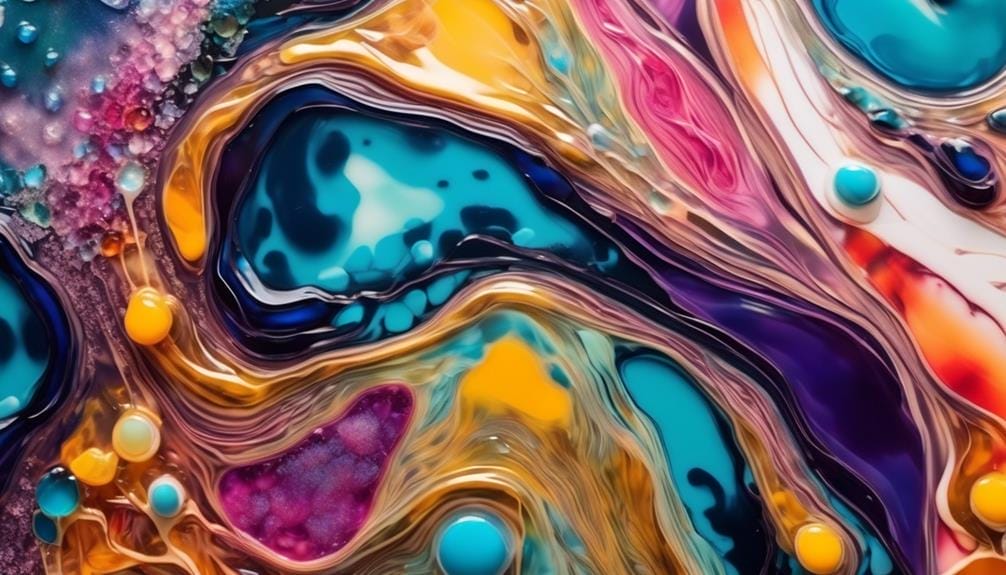
Resin art and acrylic pouring are two distinct techniques that offer artists different approaches to creating abstract artwork. While both techniques involve the creation of abstract designs, there are notable differences between resin art and acrylic pouring.
- Control: Resin art allows for more control over the final result. Its longer curing time gives artists the ability to manipulate the resin and create three-dimensional effects. On the other hand, acrylic pouring often results in unpredictable organic patterns and cells, with less control over the outcome.
- Beginner-Friendly: Acrylic pouring is generally more beginner-friendly and cost-effective. It requires minimal additional materials and can be done without prior art experience. In contrast, resin art demands careful handling of toxic materials, proper ventilation, and meticulous surface preparation, making it less accessible for beginners.
- Finish: Resin art pieces tend to have a glass-like finish, depth, and high sheen, offering a more polished and professional appearance. Acrylic pouring artworks, on the other hand, often have a matte or satin finish with a more textured and porous surface.
These differences between resin art and acrylic pouring provide artists with diverse options for creating abstract artworks. Whether an artist prefers the control and three-dimensional effects of resin art or the unpredictable patterns and beginner-friendly nature of acrylic pouring, both techniques offer unique opportunities for artistic experimentation and creative expression.
Caring for and Displaying Abstract Resin Art
The care and display of abstract resin art involve essential steps to maintain its vibrant appearance and protect it from environmental factors.
To ensure the longevity of your resin art, it’s crucial to keep it away from direct sunlight. Prolonged exposure to sunlight can cause discoloration and warping over time.
Additionally, dust your resin art gently with a soft, lint-free cloth to maintain its glossy finish and prevent scratches.
When displaying your resin art, choose well-ventilated areas to avoid extreme temperatures and humidity, which can adversely affect the stability of the resin.
It’s also important to use level and appropriate hanging hardware to ensure that the art is securely and evenly displayed on walls.
Consider rotating your resin art periodically, especially in high-traffic areas with varying light sources, to prevent uneven exposure and fading.
Inspiring Examples of Abstract Resin Art
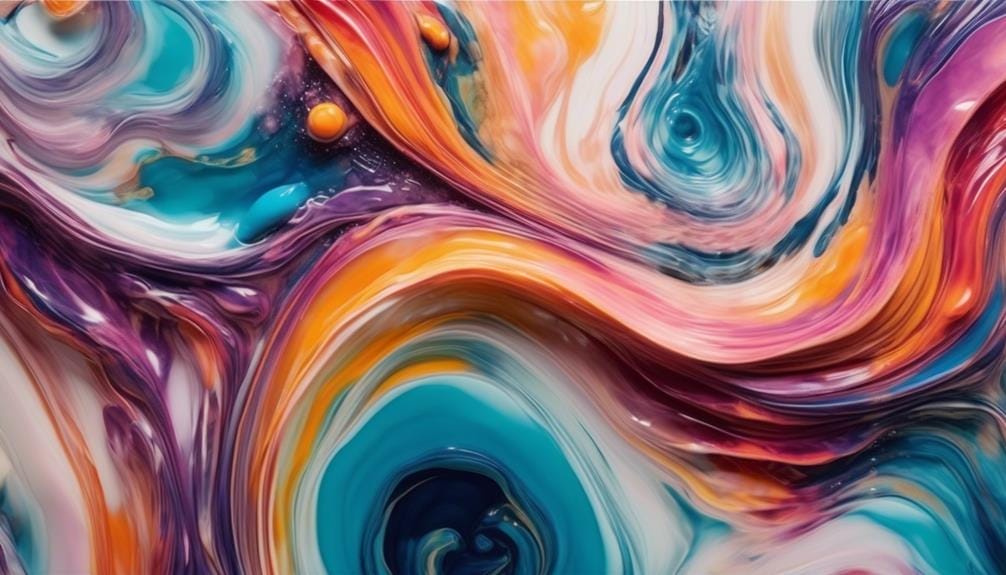
Immerse yourself in a world of captivating colors, textures, and forms with abstract resin art. This unique art form offers a diverse range of inspiring examples that will surely leave you in awe.
Here are three exceptional pieces to ignite your imagination:
- Crystal Quartz Resin Art: Etsy seller artoftexture presents a mesmerizing painting featuring shades of blue, aqua, teal, water, and silver. This ethereal artwork captures the beauty of crystal quartz, creating a stunning visual display that’s both calming and enchanting.
- Nature-Inspired Art: AssosDesignArt showcases a striking tempered glass wall piece that draws inspiration from nature. The turquoise water art piece brings a touch of the outdoors into your home with its abstract portrayal of blue hues reminiscent of tranquil waters. It adds a modern and sophisticated touch to any decor.
- Custom Resin Art: For a truly personalized touch, consider a custom order beach painting. This unique artwork features resin ocean art with washing waves, offering a beautiful abstract representation of the beach. With free shipping, this piece isn’t only visually captivating but also convenient to acquire.
Abstract resin art offers a world of endless possibilities, from luxurious geode wall art to resin-coated paintings and 3D beach scenes. With a variety of styles and budgets, there’s something for everyone to appreciate and enjoy.
Let these inspiring examples spark your imagination and fuel your passion for abstract resin art.
Frequently Asked Questions
Is Resin Art Worth the Money?
Resin art is definitely worth the money. Its unique and artistic appeal adds sophistication to any space, making it a worthwhile investment. With options for different budgets and design needs, resin art is a versatile choice.
Is Making Resin Art Expensive?
Making resin art can be expensive, but there are cost-effective alternatives. By exploring different materials, experimenting with techniques, and investing in quality supplies, you can create stunning artwork without breaking the bank.
What Is the Difference Between Art Resin and Epoxy Resin?
Art resin and epoxy resin have differences in formulation, clarity, safety, and application. Art resin is designed for artwork, while epoxy resin is more general-purpose. Art resin remains clear and maintains color, while epoxy resin may be yellow. Art resin is often safer and has a longer working time, while epoxy resin cures faster and generates more heat.
Is Resin Art Difficult?
Resin art can be challenging, but with practice and patience, you can master it. Understanding resin techniques like layering and pigments is crucial. Keep in mind the environmental factors and safety precautions while creating your beautiful resin artwork.
Conclusion
In conclusion, abstract resin art offers artists a dynamic and captivating medium to express their creativity.
With its glossy finish and vibrant colors, resin art creates visually stunning pieces that are sure to grab the attention of any viewer.
Whether it’s a painting, sculpture, or jewelry, abstract resin art allows for endless possibilities and unique designs.
So, if you’re looking for a way to add a touch of artistic flair to your space, consider incorporating abstract resin art into your collection.
It’s a true masterpiece waiting to be discovered.


